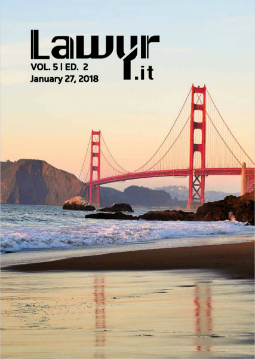1. Introduction
‘Fashion is not something that exists in dresses only. Fashion is in the sky, in the street, fashion has to do with ideas, the way we live, what is happening.’ Coco Chanel
Law as a science has to adapt to new challenges. Due to social, economic, and technical growth society and subsequently the law face new difficulties that need to be legally regulated. Fashion has always been a part of everyday life, but recently, due to the emergence of intellectual property rights and varied issues in business and other legal fields, a new legal discipline has been created. This article is an introduction to fashion law. In the first part, the history of fashion is analysed and the term is divided into three main categories. In the second part, the article introduces fashion as a legal discipline, its creator, and the main issues fashion law currently deals with.
2. What is fashion?
When a person hears the word ‘fashion’, most people automatically associate it with clothes. However, fashion does not mean only clothes but also jewelry, cosmetics, and perfumery. Fashion in general means a person's style, a certain behaviour, and the way they can express their personality. It is also a means of nonverbal communication. Fashion has always been a central part of people's lives, therefore it is not only a form of art but also a significant industry.
Fashion as an industry began in the 17th century, having its centre in Paris, France. French royalty wanted to dress excellently and be unique, therefore the best fashion designers were working for the royal family. That was the moment when haute couture began its existence. However, the formal creator of haute couture is Charles Frederick Worth. In the 19th century, Worth opened his first shop with clothes in Paris (Werlin, 2010). Only rich clients could afford to spend money on Worth’s garments. They had to first visit the designer, choose the fabrics and colours, have their measurements taken, and only then the designer would sew a bespoke piece of clothing.
Haute couture can be translated into English as ‘high-sewing’. Dresses are made from exclusive quality fabrics and intricately sewed, which is time-consuming and resulted in the high price of the end products. In 1973, the French Federation of Fashion and of Ready-to-Wear Couturiers and Fashion Designers was created. In 2017 it was renamed as Federation of Haute Couture and Fashion. Nowadays, the title haute couture is granted every year to fashion designers by the chambre syndicale de la haute couture seated at the Ministry of Industry in Paris (Elle, 2010). These designs must meet special criteria. Products have to be created and sewed for private clients (not the public in general), the fashion atelier needs to employ at least fifteen people as full-time crew, the collections must be made exclusively in Paris, and twice a year a new collection (day and evening gowns) consisting of at least 35 outfits has to be introduced (The Fashion Law, 2019).
Fashion designers and fashion products, mostly in the 19th and 20th centuries, started to be closer to the ‘average’ consumer. Not everyone could afford to buy haute couture dresses. This is the reason why made-to-measure fashion exists, a standard-sized range of clothing, made worldwide and according to lower standards of quality that makes the clothes cheaper. However, besides haute couture and made-to-measure a third category exists, namely fast-fashion. This is based on recent fashion trends, thus products are considered to be stylish for a short period of time. The products are usually made from cheap and synthetic materials, meaning durability is reduced. The manufacturing process is not environmentally friendly. Most of the products are made in Asia, which causes several legal issues, with human rights and labour law raising concerns the most. Intellectual property law problems also arise since fast fashion copies ideas from protected fashion houses.
Fashion law in Europe is considered to be an emerging legal field. However, in the United States, one can talk about fashion law as an autonomous legal discipline. This is due to the fact that the fashion industry’s social and economic importance grew rapidly, representing a $1.7 trillion dollar global industry (Jimenez, Kolsun, 2016). The pioneer of fashion law is Susan Scafidi, who created the ‘Counterfeit Chic’ blog in 2005. Later she also founded The Fashion Law Institute headquartered at Fordham Law School, which introduced the first law school courses in fashion law. The Institute itself is the world’s first centre dedicated to the law and business of fashion.
As already mentioned, in the United States fashion law is accepted as an autonomous legal discipline. It is described as follows: ‘Fashion law embraces the legal substance of style, starting with the designer’s original idea and continuing all the way to the consumer’s closet’ (Furi-Perry, 2013). A relevant question is whether the average consumer would pay the same amount of money for an item of clothing from a no-name brand as for one from a well-known brand. Given that in general the answer to this question is negative, the conclusion is that fashion is not just the business of selling clothes, but also the business of selling intellectual property. As such, the key legal norms and regulations that concern fashion law are intellectual property law provisions.
Jimenez and Kolsun (2016) divide fashion law into three subsystems in their book: fashion intellectual property, fashion business law, and fashion public law. We shall take a closer look at every subsystem mentioned.
2.1. Fashion Intellectual Property
As it has already been mentioned above, the key legal regulations for fashion law are intellectual property laws. Fashion items in Europe are generally protected by trademark and sometimes by copyright laws. Once the designer obtains the legal protection for his/her creations, nobody is allowed to recreate them without permission. However, due to fast fashion counterfeits, knock-offs, infringements on trademarks, and grey market goods, the protection of these trademarked or copyrighted creations is a daily struggle. The infringement of intellectual property is an enormous issue, as the size of the illegal industry is 5-7 percent of the global trade or between $500-600 billion annually. This represents a profit double than that from the sale of illegal drugs worldwide (Ballard et. al., 2016).
Taking Faux’s (2013) work on the different types of illegal recreation of clothing articles as a template, we shall look briefly at differences between the infringing activities that currently exist. A counterfeited item is identical to the original one and therefore infringing upon the trademark of that product. A knock-off item is a copy resembling the original closely without being identical to it. In this case, the original and the copied item are both legally protected. An infringement on a trademark may cause confusion with a prior existing legally protected fashion item, although we cannot immediately talk about a counterfeit or a knock-off. What needs to be observed is the likelihood of confusion. Another issue is which brands deal with is the situation when goods are made by authorized sources but are later sold in an unauthorized market. This can cause the loss of the owner’s control over the brand’s reputation.
Even though fashion relies on inspiration, it is important to mention the great difference between inspiration and imitation. When one imitates, the final product is a copy or substantial copy of other artistic work. However, when the designer is inspired, the product is inspired by existing elements and later these elements are interpreted in an original way (The Fashion Law, 2019).
Usually, new designers and fast-fashion houses imitate other products. However, this observation should not be generalised. In the fashion world we can find the opposite as well, as even big fashion houses are sometimes widely inspired or worse, they imitate either small designer houses or traditional artistic products. Recent case law mentions issues regarding a type of bamboo bag or Navajo Nation symbols, which were used in the fashion world without giving the due mention and respect to their origin (The Fashion Law, 2019). But not only fashion products are copied. Fashion houses fight legal battles over the unlawful use of their logos. Cases worth mentioning are Chanel v. EUIPO – Jing Zhou (Ornament), Louis Vuitton Malletier v. OHIM, Nanu-Nana, and Polo/Lauren Company LP v. OHIM, FreshSide Ltd. Moreover, infringing on intellectual property rights can result in holding the unauthorised user liable by imposing a fine (compensation) or in serious cases pressing criminal charges.
2.2. Fashion Business Law
Besides intellectual property law, fashion law also has a strong foundation in business law. Fashion business law consists of several legal disciplines. Some of those fields include licensing (if the designer, holder of the license gives approval to a licensee to use his intellectual property rights), competition law, human rights law (problems concerning labour abuses in factories), labour law, and others.
2.3. Fashion Public Law
Similarly to the previous discipline, fashion public law encompasses several other legal branches. The most outstanding ones are freedom of speech (concerning what message the artist can convey and how it can be limited) and criminal law (a criminal aspect of fashion law are the counterfeit and grey market goods).
3. Conclusion
The present article aimed to introduce the reader to the concept of fashion law. The definition of fashion, history, and its divisions were provided. The reader has also been introduced to the beginning of fashion in France in the 17th century and the development from haute couture to made-to-measure fashion. In modern times, fashion as a form of art and as an industry faces several difficulties, which the law needs to find answers to.
By Šárka Šilhánková
This material was published in Lawyr.it Vol. 6, September 2020, available only online.
References
Books
Faux, D. H. (2013) The American Bar Association's Legal Guide to Fashion Design. Chicago, American Bar Association.
Furi-Perry, U. (2013) The Little Book of Fashion Law. Chicago, Illinois, American Bar Association.
Jimenez, G. & Kolsun, B. (2016) Fashion Law: Cases and Materials. Durham, Carolina Academic Press.
Silvanic, M. (ed.), (2016) Navigating Fashion Law: Leading Lawyers on Exploring the Trends, Cases, and Strategies of Fashion Law. Boston, Aspatore.
Case law
Judgment of the General Court (Fourth Chamber), from the18th July 2017, Chanel v. EUIPO - Jing Zhou (Ornement). In Case T-57/16. Source: http://curia.europa.eu/juris/document/document.jsf;jsessionid=A53F112CA837CDE06F4C83F2CD9D4AE3?text=&docid=192882&pageIndex=0&doclang=EN&mode=lst&dir=&occ=first&part=1&cid=3413000.
Judgment of the General Court (Second Chamber), 21 April 2015, Louis Vuitton Malletier v. OHIM - Nanu-Nana. In Case T-359/12. Source: http://curia.europa.eu/juris/document/document.jsf?text=&docid=163833&pageIndex=0&doclang=EN&mode=lst&dir=&occ=first&part=1&cid=3413679.
Judgment of the General Court (Sixth Chamber), 18 September 2014, Polo/Lauren v. OHIM – FreshSide. In Case T-265/13. Source: http://curia.europa.eu/juris/document/document.jsf?text=&docid=157847&pageIndex=0&doclang=EN&mode=lst&dir=&occ=first&part=1&cid=3415007.
Articles
Elle, (2019) Co Je Haute Couture? [online] Burda International CZ s.r.o., Source: https://www.elle.cz/moda/navrhari/co-je-haute-couture, [Accessed: 13.10.2019].
Fashion Law Institute, (2018) Fashion Law Institute [online] Source: https://fashionlawinstitute.com/about, [Accessed: 13.10.2019].
Scafidi, S., (2013) Counterfeit Chic [online]. Source: http://counterfeitchic.com/, [Accessed: 13.10.2019].
The Fashion Law, (2019) Hours, Clients, Millions of Dollars: Haute Couture by the Numbers. [online]. TFL LLC, Source: http://www.thefashionlaw.com/home/haute-couture-by-the-numbers, [Accessed: 13.10.2019].
The Fashion Law, (2019) Cult Gaia Did Not Invent the Bamboo Bag but is Claiming Exclusive Rights Nonetheless. [online] TFL LLC, Source: http://www.thefashionlaw.com/home/cult-gaia-did-not-invent-the-bamboo-bag-but-is-claiming-exclusive-rights-nonetheless, [Accessed: 13.10.2019].
The Fashion Law, (2019) What Are Fashion Brands Really Selling? [online]. TFL LLC, Source: http://www.thefashionlaw.com/home/what-are-brands-really-selling, [Accessed: 13.10.2019].
The Fashion Law, (2019) When Is Inspiration Just Inspiration and Not "Imitation"? [online]. TFL LLC, Source: http://www.thefashionlaw.com/home/when-is-inspiration-just-inspiration-and-not-imitation, [Accessed: 13.10.2019].
The Fashion Law, (2019) Urban Outfitters, Navajo Nation Settle 4 Year Long Lawsuit [online]. TFL LLC, Source: http://www.thefashionlaw.com/home/urban-outfitters-navajo-nation-settle-4-year-long-lawsuit, [Accessed: 13.10.2019].
Worth, C. F., (2019) The Fashion Historian [online] Katy Werlin and The Fashion Historian, Source: http://www.thefashionhistorian.com/2010/03/charles-frederick-worth.html, [Accessed: 13.10.2019].






